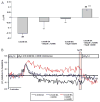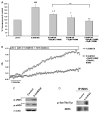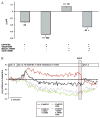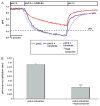A novel mechanism of acid and bile acid-induced DNA damage involving Na+/H+ exchanger: implication for Barrett's oesophagus
- PMID: 20876775
- PMCID: PMC3087378
- DOI: 10.1136/gut.2010.213686
A novel mechanism of acid and bile acid-induced DNA damage involving Na+/H+ exchanger: implication for Barrett's oesophagus
Abstract
Objective: Barrett's oesophagus is a premalignant disease associated with oesophageal adenocarcinoma. The major goal of this study was to determine the mechanism responsible for bile acid-induced alteration in intracellular pH (pH(i)) and its effect on DNA damage in cells derived from normal oesophagus (HET1A) or Barrett's oesophagus (CP-A).
Design: Cells were exposed to bile acid cocktail (BA) and/or acid in the presence/absence of inhibitors of nitric oxide synthase (NOS) or sodium-hydrogen exchanger (NHE). Nitric oxide (NO), pH(i) and DNA damage were measured by fluorescent imaging and comet assay. Expression of NHE1 and NOS in cultured cells and biopsies from Barrett's oesophagus or normal squamous epithelium was determined by RT-PCR, immunoblotting or immunohistochemistry.
Results: A dose dependent decrease in pH(i) was observed in CP-A cells exposed to BA. This effect of BA is the consequence of NOS activation and increased NO production, which leads to NHE inhibition. Exposure of oesophageal cells to acid in combination with BA synergistically decreased pH(i). The decrease was more pronounced in CP-A cells and resulted in >2-fold increase in DNA damage compared to acid treatment alone. Examination of biopsies and cell lines revealed robust expression of NHE1 in Barrett's oesophagus but an absence of NHE1 in normal epithelium.
Conclusions: The results of this study identify a new mechanism of bile acid-induced DNA damage. We found that bile acids present in the refluxate activate immediately all three isoforms of NOS, which leads to an increased NO production and NHE inhibition. This consequently results in increased intracellular acidification and DNA damage, which may lead to mutations and cancer progression. Therefore, we propose that in addition to gastric reflux, bile reflux should be controlled in patients with Barrett's oesophagus.
Conflict of interest statement
Figures








Similar articles
-
Bile acids in combination with low pH induce oxidative stress and oxidative DNA damage: relevance to the pathogenesis of Barrett's oesophagus.Gut. 2007 Jun;56(6):763-71. doi: 10.1136/gut.2006.103697. Epub 2006 Dec 4. Gut. 2007. PMID: 17145738 Free PMC article.
-
Bile acids directly augment caudal related homeobox gene Cdx2 expression in oesophageal keratinocytes in Barrett's epithelium.Gut. 2006 Jan;55(1):16-25. doi: 10.1136/gut.2005.066209. Epub 2005 Aug 23. Gut. 2006. PMID: 16118348 Free PMC article.
-
Bile acid-induced expression of activation-induced cytidine deaminase during the development of Barrett's oesophageal adenocarcinoma.Carcinogenesis. 2011 Nov;32(11):1706-12. doi: 10.1093/carcin/bgr194. Epub 2011 Sep 1. Carcinogenesis. 2011. PMID: 21890457
-
Bile acids and Barrett's oesophagus: a sine qua non or coincidence?Scand J Gastroenterol Suppl. 2006;(243):11-7. doi: 10.1080/00365520600664219. Scand J Gastroenterol Suppl. 2006. PMID: 16782617 Review.
-
From Reflux Esophagitis to Esophageal Adenocarcinoma.Dig Dis. 2016;34(5):483-90. doi: 10.1159/000445225. Epub 2016 Jun 22. Dig Dis. 2016. PMID: 27331918 Free PMC article. Review.
Cited by
-
Does a melatonin supplement alter the course of gastro-esophageal reflux disease?World J Gastrointest Pharmacol Ther. 2011 Dec 6;2(6):50-1. doi: 10.4292/wjgpt.v2.i6.50. World J Gastrointest Pharmacol Ther. 2011. PMID: 22180850 Free PMC article.
-
Dickkopf-1, the Wnt antagonist, is induced by acidic pH and mediates epithelial cellular senescence in human reflux esophagitis.Am J Physiol Gastrointest Liver Physiol. 2014 Apr 1;306(7):G557-74. doi: 10.1152/ajpgi.00153.2013. Epub 2014 Jan 30. Am J Physiol Gastrointest Liver Physiol. 2014. PMID: 24481601 Free PMC article.
-
Diagnostic Principles for Chronic Gastritis Associated with Duodenogastric Reflux.Diagnostics (Basel). 2023 Jan 4;13(2):186. doi: 10.3390/diagnostics13020186. Diagnostics (Basel). 2023. PMID: 36672996 Free PMC article. Review.
-
Elevation of fatty acid desaturase 2 in esophageal adenocarcinoma increases polyunsaturated lipids and may exacerbate bile acid-induced DNA damage.Clin Transl Med. 2022 May;12(5):e810. doi: 10.1002/ctm2.810. Clin Transl Med. 2022. PMID: 35560527 Free PMC article.
-
Advances in research on the regulatory mechanism of NHE1 in tumors.Oncol Lett. 2021 Apr;21(4):273. doi: 10.3892/ol.2021.12534. Epub 2021 Feb 10. Oncol Lett. 2021. PMID: 33717270 Free PMC article. Review.
References
-
- Rastogi A, Puli S, El-Serag HB, et al. Incidence of esophageal adenocarcinoma in patients with Barrett’s oesophagus and high-grade dysplasia: a meta-analysis. Gastrointest Endosc. 2008;67:394–8. - PubMed
-
- Menges M, Muller M, Zeitz M. Increased acid and bile reflux in Barrett’s oesophagus compared to reflux esophagitis, and effect of proton pump inhibitor therapy. Am J Gastroenterol. 2001;96:331–7. - PubMed
-
- Ostrowski J, Mikula M, Karczmarski J, et al. Molecular defense mechanisms of Barrett’s metaplasia estimated by an integrative genomics. J Mol Med. 2007;85:733–43. - PubMed
-
- Lindahl T, Nyberg B. Rate of depurination of native deoxyribonucleic acid. Biochemistry. 1972;11:3610–18. - PubMed
-
- LeBoeuf RA, Kerckaert GA. The induction of transformed-like morphology and enhanced growth in Syrian hamster embryo cells grown at acidic pH. Carcinogenesis. 1986;7:1431–40. - PubMed
Publication types
MeSH terms
Substances
Grants and funding
LinkOut - more resources
Full Text Sources
Miscellaneous
